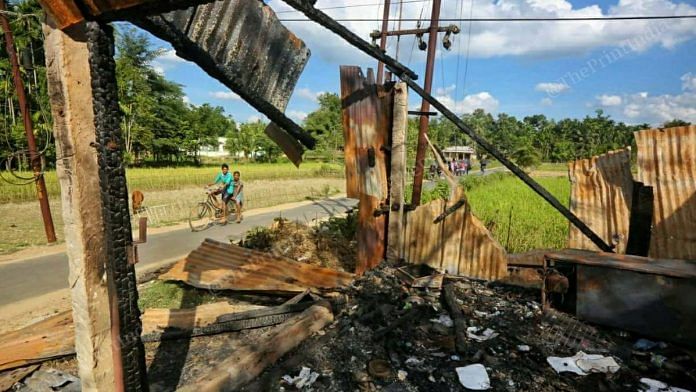North Tripura/Sepahijala/Gomati: For nearly a month now, Tripura has been at the centre of a seething controversy following reports of a slew of attacks on mosques across the state. According to these reports, mosques and Muslim-owned shops had been vandalised in the week between 19 October and 26 October.
However, the Union Home Ministry has said there had been no reported case of damage to the structure of any mosque in Tripura in the recent past.
The alleged incidents in Tripura took place just days after a man in Bangladesh’s Comilla district had placed a Quran in a Durga Puja pandal, which sparked communal violence in several districts of the country. Hindu-owned shops and businesses were set afire, and homes were attacked. Three people were killed in the violence in Bangladesh, before the main accused was arrested.
While the Tripura Police on 28 October said that the situation was normal, photos and videos widely shared over social media claimed otherwise. Then, on 3 November, the police booked 102 people holding social media accounts, including journalists and rights activists, under the Unlawful Activities (Prevention) Act over “distorted and objectionable news items/statements”.
The Union Ministry of Home Affairs Saturday also raised an issue with some social media posts, which it said were a “complete misrepresentation of facts”. While denying that any mosque in Tripura was damaged, the MHA specifically referred to the Dargabazar mosque in the Kakraban area of Gomati district as one of them.
V.S. Yadav, Director General of Police, Tripura, said that the few incidents that did happen had been in protest against what took place in Bangladesh.
“We have filed 21 cases till now,” he added. Yadav said 24 people have been arrested so far— including alleged rioters, journalists and social media account holders. Although those arrested include the two journalists Samriddhi Sakunia and Swarna Jha (released on bail), he did not give any other detail on the identity of the others who have been arrested.
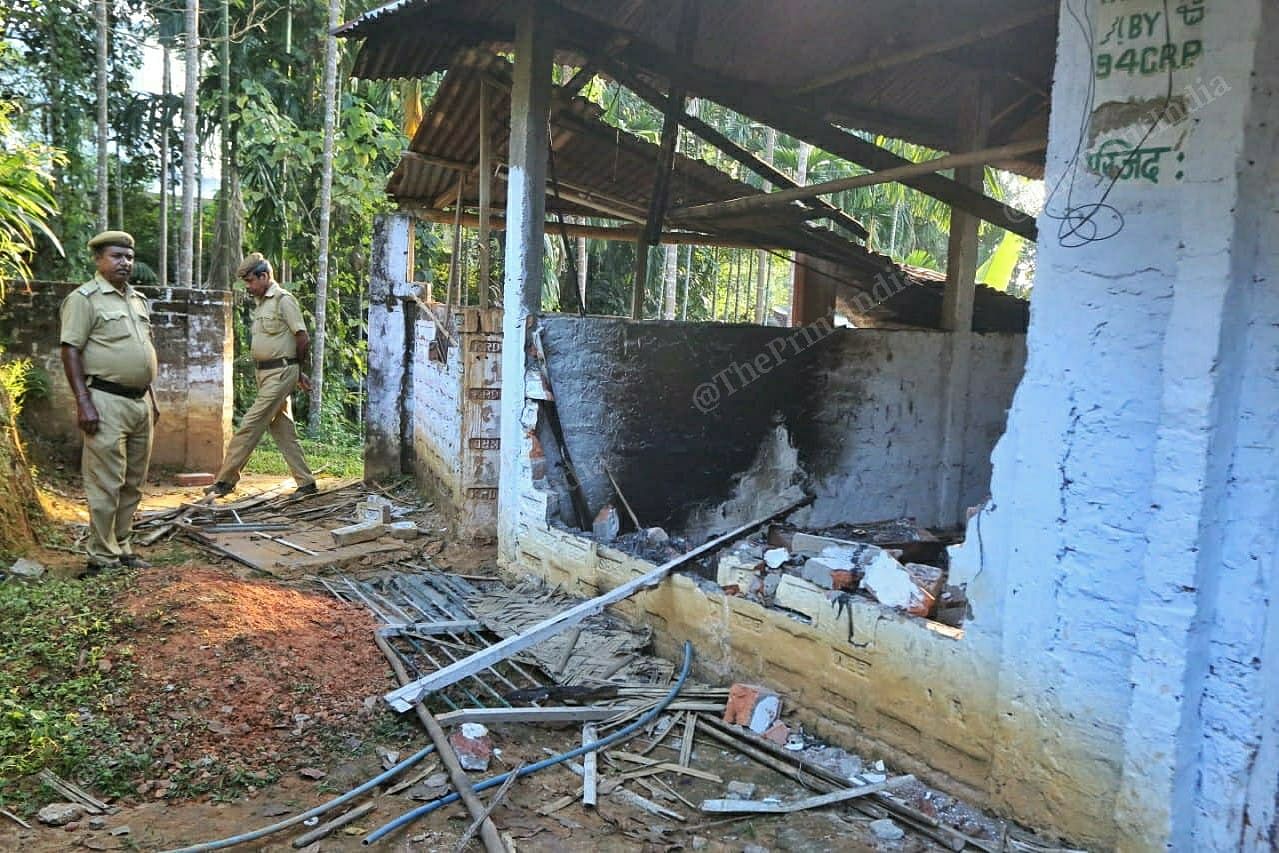
As the question whether these ‘attacks’ actually occurred, how serious they were, and who the supposed perpetrators might be is still being debated, ThePrint travelled across the state to investigate the sequence of events and the story on the ground.
Also Read: Muslim group allege ‘political conspiracy’ in Tripura communal violence, claim minority targeted
Dargabazar, Gomati district
The first mosque targeted was the one in Dargabazar, in the Harijala panchayat of Gomati district. The Harijala Dargabazar mosque, as local residents call it, had been set ablaze by unknown assailants on the night of 19 October.
When ThePrint visited the site three weeks after the incident, the 12 ft x 6 ft tin structure was gutted on one side, its tin walls bent from the fire. Inside, a layer of ash covered the floor strewn with broken remains of the walls, a damaged fan and wooden logs. A small cabinet stood atop a pile of bricks in a corner of the room atop which were steel plates that had also been partially destroyed in the fire.
In the other corner lay a few partially burnt pages of the Quran and an elementary Urdu text.
Rahamat Ali, secretary of the Harijala Dargabazar Mosque, says that it was his son who had first spotted the fire at 1.30 am.
The First Information Report (FIR) filed on 20 October, which was accessed by ThePrint, noted that after seeing a fire in front of the mosque, Rakesh Miah (Ali’s son) “raised shouting and on hearing shout others family members as well as local people there came there and try to mitigate the fire [sic]”.
It also adds that “due to the fire incident, partial part of the said masjid gutted by fire and all the articles fully barn (burn) due to the fire [sic]”.
However, the fire service soon reached the spot and managed to control the fire. “My son couldn’t see who had done this. We don’t suspect anyone. We don’t know who could’ve done such a thing. Out here, Hindus, Muslims and tribals have been living together without problems,” Ali said.
According to Ali, the losses are estimated at Rs 2-2.5 lakh. “There was a fan, plates, microphone, everything was burnt… the Quran was also burnt,” he alleged. Jhutan Das, a local BJP worker, visited the site at 8.30 am. “I went inside the mosque as well. Everything had been burnt, including pages of the Quran,” Das said.
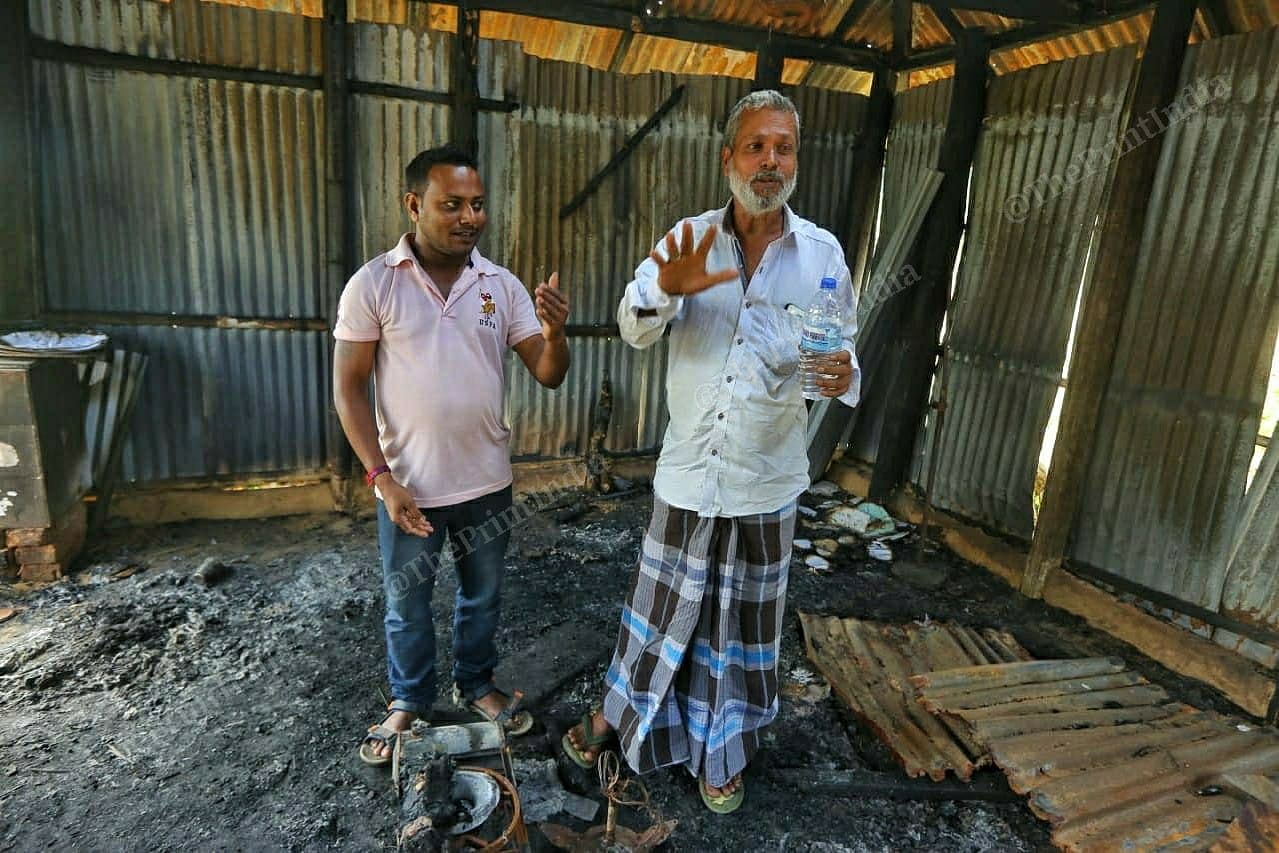
The circumstances, claims and rebuttals linked to the burnt pages of the Quran have, however, become controversial.
DGP Yadav denied that the holy text had been burnt in the incident: “Our firemen and police personnel went to the spot, we didn’t find any burnt Quran. There’s no mention of it in the FIR either.”
He said the issue of the burnt Quran had only been raised by a group of lawyers from Delhi who had visited the spots, after which they had released a report on 3 November. “In case this is what they had found, they should have reported this to the police. Given that they are lawyers, they know the system and such evidence, if it does exist, should have been reported to police.”
The lawyers were on an independent fact-finding and legal assistance mission to Tripura after the riots.
Ali and his son Rakesh, however, insist that the Quran was among the things that got burnt.
“The (burnt) pages of the Quran were there, the four lawyers who came from Delhi, they had taken the Quran with them. After that some pages were left behind,” he told ThePrint.
Ali said the policemen who visited the mosque the next morning made a seizure list of items at the spot and took them to the police station. “I didn’t know that I had to include the Quran in the seizure list. This is why I didn’t tell them,” he claimed. “The police didn’t see the Quran was burnt, they got inside and saw the fan and everything. They didn’t see the Quran burnt there and we didn’t think of showing it to them either.”
Ali claimed that he had subsequently asked the police to include it in the seizure list but was told it was not possible as the list had already been “submitted”.
Sub-Inspector Mizanur Rahaman said while it is commonplace for a mosque to have a copy of the Quran, he and his team did not see it when they visited the premises after the attack.
“The incident happened on 19 and 20 October and no one said anything (about the Quran) until 31 October. Even I hadn’t seen anything until then. It was only when the lawyers came and did the press conference that this was highlighted. No one said anything until then. If we don’t find the Quran how can we include it in the seizure list?” Rahaman asked.
Khas Chowmuhani, Sepahijala
On the same night of 19 October, at Khas Chowmuhani village in Sepahijala district, over 20 km away from Dargabazar, there were two more incidents where mosques were targeted.
Aashiq Mustafa, an imam at the Madinatur Nur Jame Masjid, said, “At 12-1 am, someone came and took away the microphone. The person who calls the azaan came at 4 am and noted the missing microphone. He called in the mosque committee, after which we complained to the police.”
The police complaint filed by a local resident at the Melaghar Police Station noted that the mosque was closed at 9 pm, after which the theft took place. Villagers also alleged that there had also been an attempt to set a dilapidated, old mosque on fire about a km away. “In Khas Chowmuhani’s purba pada (purba street), an old mosque was set afire, and a section was damaged,” the complaint adds.
“There is another, old masjid, but we don’t offer namaz there. A burning cloth was thrown at it. Hindus staying nearby came out and put off the fire,” said Mustafa. This was echoed by eight-year-old Parvez Hussain, who lives a few metres away.
When ThePrint visited the mosque, a section of an old, white wooden window had taken on a blackish hue. There was no other damage.
Naraura, Sepahijala
The pattern of covert, late-night attacks by unidentified people was again witnessed three days later on 23 October, this time in the small, picturesque village of Naraura, in Sepahijala. “We had just slept when we heard the crackle of a fire. We came outside and saw something burning near the mosque. After we screamed, everyone came and put it out,” villager Taslima Begum tells ThePrint.
Parts of the mosque’s tin walls were discoloured, outside it lay a heap of partially burnt jute mats and a wooden janaza (cot used to carry dead bodies), parts of which had turned black. A signboard hung on the mosque wall was damaged too, rendering the words illegible.
“They had sprayed kerosene all around. At first we couldn’t go close because of the smell,” said 20 year-old Mubarak Miah, a resident of Naraura and the complainant in the case lodged at the Bishalgarh police station. According to Miah, it had been difficult to spot the perpetrators in the dark.
The complaint attached to the FIR notes: “With the aim of disturbing the harmony of the locality a group of anti-social elements, had set fire in the mosque on 23 October between 9.30 pm and 10 pm.”
The incident sent shockwaves through the 47 families living in Naraura. “There are Hindus living all around and we are in the middle. There has been no trouble with anyone. In fact, they came to check in on us when this happened,” Miah said.
Nalchar/Bairagi Bazaar, Sepahijala
These series of incidents came to a head four days later. On 26 October, in the Melaghar area, the BJP took out a ‘procession’ to protest against the communal riots in Bangladesh.
Sabak Das, the local BJP leader, told ThePrint, “This happened about 15 days before, for the Bangladesh incidents where Hindus were mistreated.”
The rally covered the stretch from Bairagi Bazaar to Nalchar, located along the Melaghar-Sonamura Road. A little ahead of Bairagi Bazar, the road divides a local dargah and a Hindu ashram, which the local residents refer to as Ramthakur Ashram.
A cleaner at the ashram alleged that after the rally passed, they found the single grave located outside the dargah had been vandalised and its tin shed broken.
“There was a big procession. After it passed we saw that the kabr (grave) was broken,” she said. “Us Hindus and Muslims light agarbatti and candles at the dargah and ashram during Lakshmi and Kali puja. The point is you follow your religion, let us follow ours.”
A few kilometres down the road, the South Nalchar Jame Masjid had also been apparently vandalised.
ThePrint could spot partially burnt jute mats and a partly damaged metal janaza. Abdul Qadir, the mosque’s imam, claimed, “They started a fire right in front of the mosque. A ceiling fan kept at one side which we wanted to install was damaged.”
According to Qadir, the incident is likely to have taken place between 22 October and 29 October, a period during which he had visited the mosque just once.
Das, the BJP leader, denies the occurrence of both incidents. “There have been no incidents of this sort here. They never happened, otherwise we would have known.”
Also Read: Muslim group allege ‘political conspiracy’ in Tripura communal violence, claim minority targeted
Panisagar, North Tripura
Among the incidents that made headlines was the one in Panisagar, a town in North Tripura district, that took place on 26 October. During a protest rally by the Vishva Hindu Parishad (VHP) against the incidents in Bangladesh, a mosque and several Muslim-owned shops were allegedly vandalised. The rally, said local VHP leader Bijit Roy, started around 2.30 pm at Panisagar and went to Chamtilla and then the Rowa area, before turning back to Panisagar.
Eyewitnesses, local VHP leaders and police officers, however, are at odds with each other on the number of people present at the rally. The estimates vary from 2,500 to well over 10,000, though the town itself, according to the 2011 census, has a population of just 14,758.
According to the FIR that was filed at the Panisagar Police Station on 27 October, “When the rally reached Rowa Market… a group of miscreants from the rally torched a few shops and stole things from those shops… The miscreants then attacked some houses and ransacked the properties which were worth Rs 20 lakh and they outraged the modesty of women. They also tried to attack the Rowa Jame Masjid.”
Bricks and rubble lay strewn in a heap outside the Chamtilla Jame Mosque. Through its broken windows, ThePrint could spot fans whose blades had been twisted out of shape. Nearby lay 25 felled Agar trees in a line.
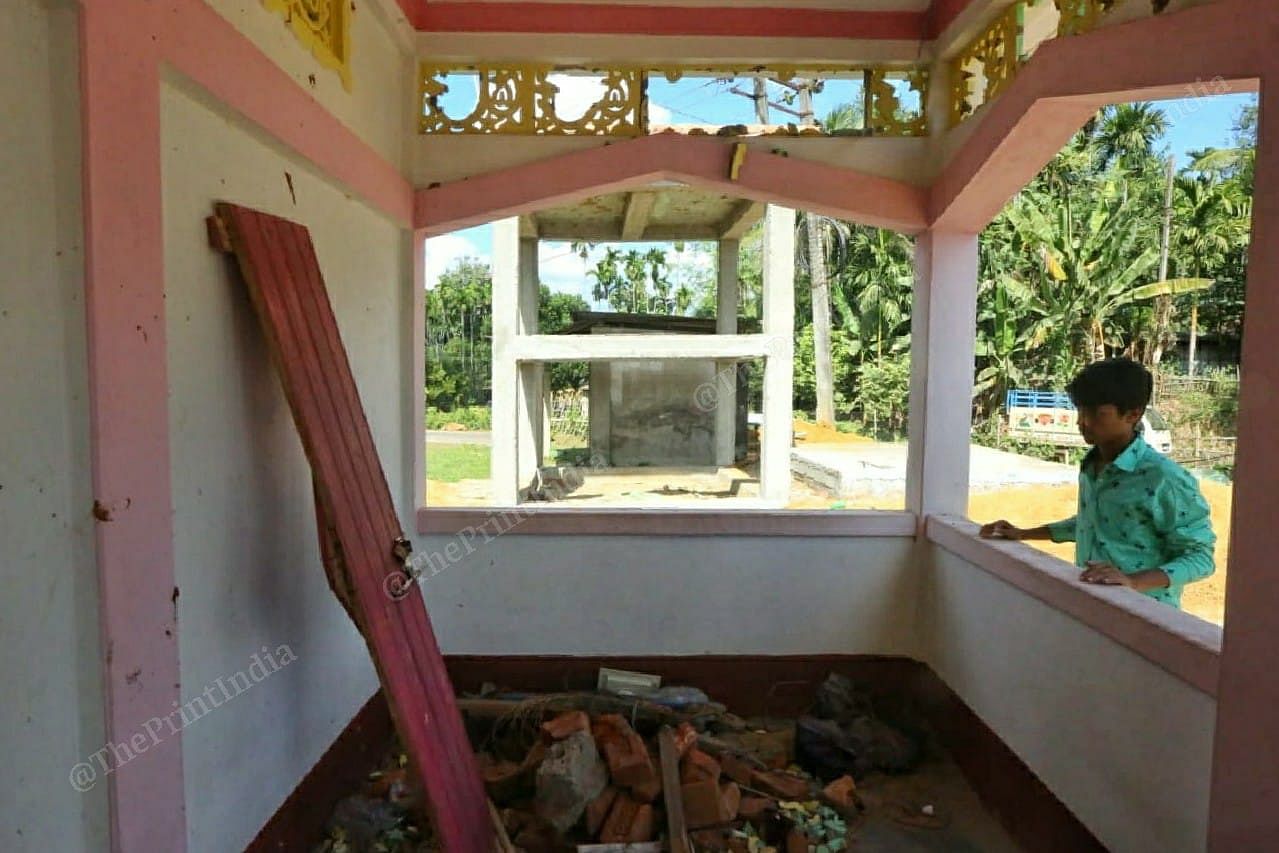
“When the rally came, they attacked the mosque and threw bricks at it,” said a local witness to events. He further claimed: “The police were there, despite this the vandalism happened. They broke the doors, ventilator and fan. They broke the microphone and took everything.”
A resident of the area said that, along with family members, he had made a run for a thicket of trees as soon as the rally approached. “When we came back at 4 pm, we saw that everything had been broken,” he added, requesting anonymity.
After Chamtilla, the rally travelled nearly 1.4 km down the road to Rowa, which has six Muslim-owned shops. According to a shopkeeper who didn’t wish to be named, people from the rally damaged the shutters of two shops. When ThePrint visited Rowa, parts of the shutters, albeit out of shape, had already been repaired.
The procession then proceeded along another row of shops a few hundred metres away. Here, at least two shops had completely been burnt to the ground, while five others were vandalised.
“I had gone for my namaz when the procession arrived. They had blocked the entire road…first they broke open the door to my shop, looted it and set it on fire. I could see this from a distance,” Amiruddin said, standing before the charred structure of his shop. “I have faced losses worth Rs 17 lakh. The whole family was depending on this; I don’t have any other way to survive. I’m surviving on what villagers are giving,” he added.
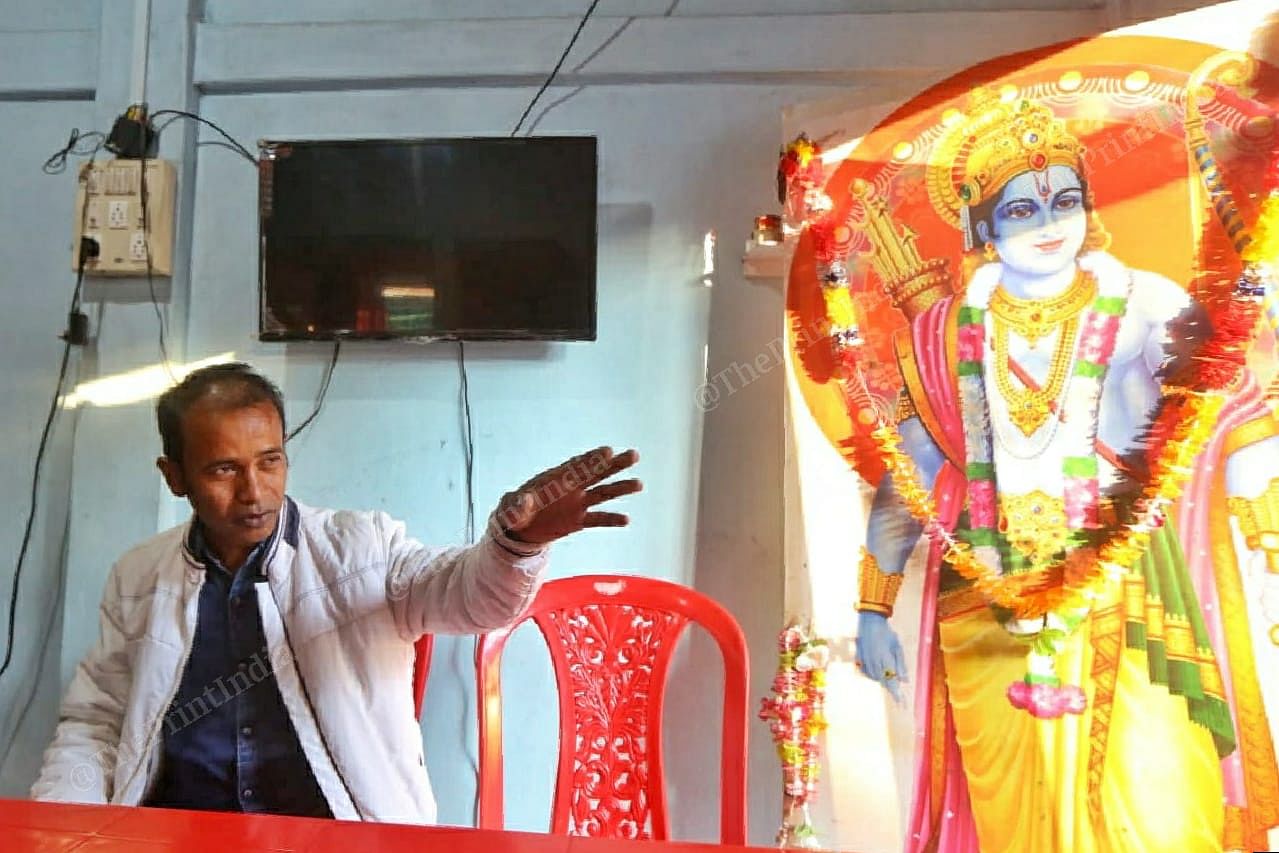
The VHP’s Bijit Roy, however, stressed that no one in the rally could be blamed for the destruction and that the chaos had only started after one of their workers was hit by a stone pelted by someone unknown. “The people who did this were not part of the procession. This was pre-planned by some people. Panisagar is the most peaceful area of Tripura,” he claimed.
(Edited by Saikat Niyogi)
Also Read: Tripura Police file FIR against 102 social media accounts in October ‘communal violence’ case


